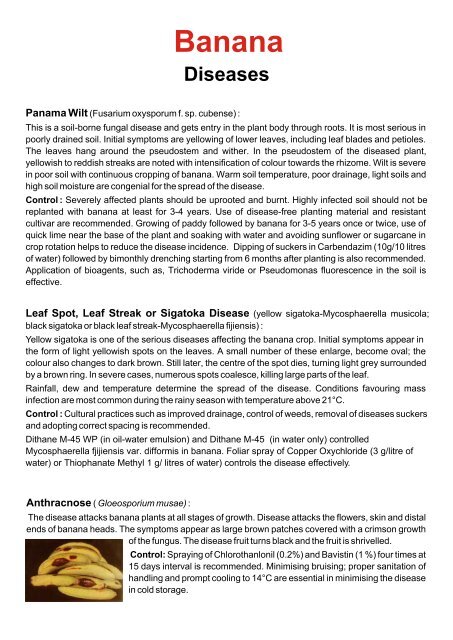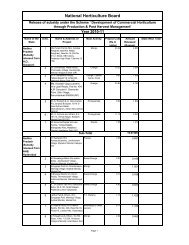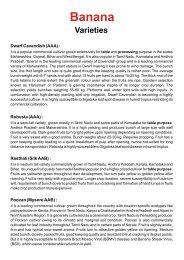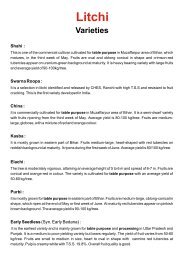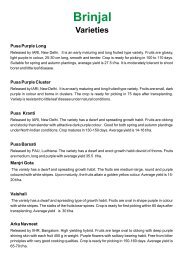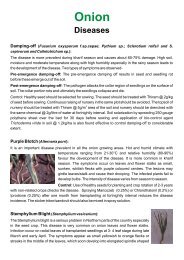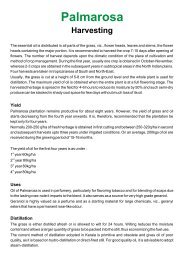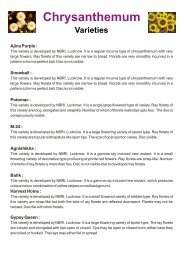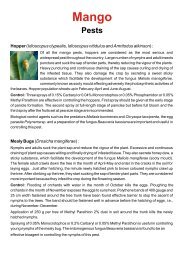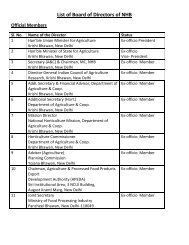Banana Diseases
Banana Diseases
Banana Diseases
You also want an ePaper? Increase the reach of your titles
YUMPU automatically turns print PDFs into web optimized ePapers that Google loves.
<strong>Banana</strong><br />
<strong>Diseases</strong><br />
Panama Wilt (Fusarium oxysporum f. sp. cubense) :<br />
This is a soil-borne fungal disease and gets entry in the plant body through roots. It is most serious in<br />
poorly drained soil. Initial symptoms are yellowing of lower leaves, including leaf blades and petioles.<br />
The leaves hang around the pseudostem and wither. In the pseudostem of the diseased plant,<br />
yellowish to reddish streaks are noted with intensification of colour towards the rhizome. Wilt is severe<br />
in poor soil with continuous cropping of banana. Warm soil temperature, poor drainage, light soils and<br />
high soil moisture are congenial for the spread of the disease.<br />
Control : Severely affected plants should be uprooted and burnt. Highly infected soil should not be<br />
replanted with banana at least for 3-4 years. Use of disease-free planting material and resistant<br />
cultivar are recommended. Growing of paddy followed by banana for 3-5 years once or twice, use of<br />
quick lime near the base of the plant and soaking with water and avoiding sunflower or sugarcane in<br />
crop rotation helps to reduce the disease incidence. Dipping of suckers in Carbendazim (10g/10 litres<br />
of water) followed by bimonthly drenching starting from 6 months after planting is also recommended.<br />
Application of bioagents, such as, Trichoderma viride or Pseudomonas fluorescence in the soil is<br />
effective.<br />
Leaf Spot, Leaf Streak or Sigatoka Disease (yellow sigatoka-Mycosphaerella musicola;<br />
black sigatoka or black leaf streak-Mycosphaerella fijiensis) :<br />
Yellow sigatoka is one of the serious diseases affecting the banana crop. Initial symptoms appear in<br />
the form of light yellowish spots on the leaves. A small number of these enlarge, become oval; the<br />
colour also changes to dark brown. Still later, the centre of the spot dies, turning light grey surrounded<br />
by a brown ring. In severe cases, numerous spots coalesce, killing large parts of the leaf.<br />
Rainfall, dew and temperature determine the spread of the disease. Conditions favouring mass<br />
infection are most common during the rainy season with temperature above 21°C.<br />
Control : Cultural practices such as improved drainage, control of weeds, removal of diseases suckers<br />
and adopting correct spacing is recommended.<br />
Dithane M-45 WP (in oil-water emulsion) and Dithane M-45 (in water only) controlled<br />
Mycosphaerella fjijiensis var. difformis in banana. Foliar spray of Copper Oxychloride (3 g/litre of<br />
water) or Thiophanate Methyl 1 g/ litres of water) controls the disease effectively.<br />
Anthracnose ( Gloeosporium musae) :<br />
The disease attacks banana plants at all stages of growth. Disease attacks the flowers, skin and distal<br />
ends of banana heads. The symptoms appear as large brown patches covered with a crimson growth<br />
of the fungus. The disease fruit turns black and the fruit is shrivelled.<br />
Control: Spraying of Chlorothanlonil (0.2%) and Bavistin (1 %) four times at<br />
15 days interval is recommended. Minimising bruising; proper sanitation of<br />
handling and prompt cooling to 14°C are essential in minimising the disease<br />
in cold storage.
Cigar End Tip Rot (Verticillium theobromae, Trachsphaera fructigena and Gloeosporium<br />
musarum):<br />
A black necrosis spread from the perianth into the tip of immature<br />
fingers. The rotted portion of the banana finger is dry and tends to<br />
adhere to fruits (appears similar to the ash of a cigar).<br />
Control : Removal of pistil and perianth by hand 8-10 days after bunch<br />
formation and spraying the bunch with Dithane M -45 (0.1%) or Topsin M<br />
(0.1%) controls the disease effectively. Minimising bruising; prompt<br />
cooling to 14°C; proper sanitation of handling facilities reduce the incidence in the cold storage.<br />
Crown Rot (Colletotrichum musae, Fusarium sp., Verticillium theobromae, Botryodiploidia<br />
theobromae and Nigrospora sphaericu) :<br />
The characteristic symptoms are blackening of the crown tissues, which spreads to the pulp<br />
through the pedicel resulting rotting of the infected portion and separation of fingers from the hand.<br />
Control : Dipping the bunches or hands in Thiobendazole or Benomyl and/or using fungicide<br />
impregnated cellulose pad for packing is recommended.<br />
Stem-end Rot (Thielaviopsis paradoxa) :<br />
The fungus enters through the cut stem or hand. The invaded flesh becomes soft and water-soaked.<br />
Control : Minimising bruising; prompt cooling to 14°C; proper sanitation of handling facilities and hot<br />
water treatment of hands (such as 5 minutes in 50°C water) helps in controlling the disease in cold<br />
storage.<br />
Pseudostem Heart Rot (Botrydiplodia sp.,Gloeosporium sp. and Fusarium sp.) :The first<br />
indication of heart rot is the presence of heart leaves with part of the lamina missing or decayed. In<br />
severe cases, the inner leaves of the crown first turn yellow, then brown and finally die. In more severe<br />
cases all the leaves and the plant die.<br />
Control : Adopting field sanitation, good drainage and proper spacing reduce the incidence of the<br />
disease. To prevent spread of the disease, spraying of Captan or Dithane M-45 or Dithane Z- 78 is<br />
effective.<br />
Head Rot (Erwinia carotovora) :<br />
Newly planted suckers get affected, leading to rotting and emitting of foul odour. In older plants rotting<br />
at the collar region and leaf bases are seen. In advanced cases, trunk base becomes swollen and split.<br />
Control : Good drainage and soil conditioning can control the disease to some extent. Use of rhizomes<br />
with dead central buds and active lateral buds prevents the appearance of the disease.
Bacterial Wilt or Moko Disease (Pseudomonas solanacearum) :<br />
The young plants are affected severely. In the initial stages the bacterial wilt is characterised by the<br />
yellowish discolouration of the inner leaf lamina close to the petiole. The leaf collapses near the<br />
junction of the lamina with the petiole. Within a week most of the leaves exhibit wilting symptoms. The<br />
presence of yellow fingers in an otherwise green stem often indicates the presence of moko disease.<br />
The most characteristic symptoms appear on the young suckers that have been cut once and begin<br />
regrowth. These are blackened and stunted. The tender leaves from the suckers turn yellow and<br />
necrotic.<br />
Control : Early detection and destruction of the suspected plants may help in preventing the spread of<br />
the disease. All the tools used for pruning and cutting should be disinfected with formaldehyde. As the<br />
insects can carry the disease causing bacterium on the male flowers, removal of the male flowers as<br />
soon as the last female hand emerge help in minimising the spread of the disease.<br />
<strong>Banana</strong> Bunchy Top Virus (BBTV) :<br />
The disease is transmitted to the plant by the aphid vector Pentalonia nigronervosa and dwarf<br />
bananas are very susceptible to this disease. Primary symptoms of the disease are seen when<br />
infected suckers are planted. Such infected suckers putforth narrow leaves, which are chlorotic and<br />
exhibit mosaic symptoms. The affected leaves are britttle with their margins rolled upwards.<br />
Characteristic symptom of bunchy top virus is the presence of interrupted dark green streaks along<br />
the secondary veins of the lamina or the midrib of the petiole. The<br />
diseased plants remain stunted and do not produce bunch of any<br />
commercial value.<br />
Control : Systematic eradication of the diseased plants, suckers and<br />
the clumps is very essential. Planting materials should not be<br />
collected from places affected by this disease. The aphid should be<br />
controlled to check spread of the disease by spraying with Metasystox<br />
(0.1-0.5%). Plants adjacent to the healthy plants should also be<br />
sprayed. The affected plant should be killed with kerosene or herbicides such as 2, 4-D or 2, 4, 5-T.<br />
The rhizome should be dug out, cut into small sections and sprayed again so that no suckers can<br />
be produced which may harbour the virus.<br />
<strong>Banana</strong> Streak Virus (BSV) :<br />
A prominent symptom exhibited by BSV is yellow streaking of the leaves, which becomes<br />
progressively necrotic producing a black streaked appearance in older leaves. . The virus is<br />
transmitted mostly through infected planting materials, though mealy bugs (Planococcus citri) and<br />
more probably Saccharicoccus sacchari are also believed to transmit it. Shoot tip culture does not<br />
eliminate it from vegetatively propagated materials.<br />
Control: Control strategies include use of clean planting material and quarantine. Eradication of<br />
infected plants and control of vectors are effective in controlling the severity of the disease.<br />
Mosaic Virus :<br />
The disease is characterised by typical mosaic symptoms on the leaves. Mosaic plants are easily<br />
recognised by their dwarf growth and mottled, distorted leaves. The earliest symptoms appear on<br />
young leaves ass light green or yellowish streaks and bands giving a mottled appearance. The aphid<br />
vector Aphis gossypii transmits the disease.<br />
Control : The plantation should be kept free from weeds. Suckers from infected clumps should not be<br />
used for planting. Weeds in the nearby area should be removed as the virus survives in them during offseason.<br />
Use of suitable insecticide to reduce spread of the disease is also suggested.
<strong>Banana</strong> Bract Mosaic Virus (BBMV) :<br />
The symptoms appear as yellow green bands or mottling over an entire area of young leaves. The<br />
affected leaves show abnormal thickening of veins.<br />
Bunch development is affected.<br />
Control : Removal and destruction of affected plants along with rhizome. Growing cucurbits in and<br />
around banana field should be avoided.


